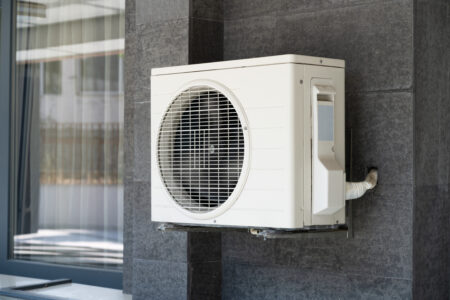A heat pump is a fantastic choice for both cooling and heating your home. When choosing which heat pump to install, you should focus on factors like energy efficiency and brand. Nonetheless, the most important factor is choosing a unit that is the correct size for your home so that your heating and air conditioning work efficiently and effectively. Sizing a heat pump or any other central HVAC unit is a fairly complicated process. This article will explain what steps are involved in the process and why each one matters.
How Square Footage and Climate Affect the Size of Heat Pump You Need
While you might think that the size of your home is what determines the size heat pump you need, this is only one part of the equation. Where you live is the biggest factor when sizing a heat pump due to the different heating and cooling requirements for different parts of the country. A home in a location with much hotter, more humid summers or colder winters will always need a larger heat pump than a home of the same size in a place with milder summer and winter weather.
The specific heating and cooling requirements for any home are measured in terms of BTUs per square foot, and these requirements are based on the climate zone the home is in. When sizing a heat pump, an HVAC technician will calculate how many BTUs per foot of heating and cooling the unit needs to produce to work as effectively as possible. In some places, both of these requirements will be around the same. If the BTU requirements for heating and cooling are different, the technician will focus on whichever requirement is the higher of the two. If not, you’d run the risk of getting a unit that only heats or cools effectively but doesn’t perform well enough when running in the other mode.
In Bellingham and the rest of Western Washington, the general rule of thumb is that you need 45-50 BTUs of heating and 35-40 BTUs of cooling per square foot. As such, a technician will primarily focus on your home’s heating requirements when sizing your heat pump. For people in hotter climates, they would instead focus on the cooling requirements.
Why Insulation and R-Values Matter
Determining the heating and cooling requirements per square foot only gives a technician a baseline of where to start. The reason is that the specific requirements for a home will also vary quite a bit depending on how well-insulated it is. In terms of cooling requirements, the most important factor is generally whether the floor of the attic is sufficiently insulated. If not, much of the heat that the heat pump brings inside will quickly be lost since it will rise through the floor into the attic instead of being trapped in the living spaces.
Insulation is rated by its R-value, which tells you how much heat resistance it provides. Each part of the country has different recommendations for what R-values are needed for the walls, ceilings, and attic to be sufficiently insulated. Older homes and homes in milder climates are often not as well insulated, which means a larger heat pump could be needed due to the heat and cold that seeps in from outside.
A technician will usually be able to estimate the level of insulation in the exterior walls just by focusing on the age and location of the home. Determining the level of insulation in the attic can easily be done by inspecting it. Specifically, the technician will look at the type of insulation, its age, and how thick it is since these factors allow them to estimate the R-value of the insulation fairly accurately.
If your home isn’t sufficiently insulated, it’s worth considering adding extra insulation before installing a new heat pump. This is because insulating your home may allow you to install a slightly smaller, less expensive unit than you would otherwise need. It will also definitely allow your heat pump to work more efficiently so your heating and cooling bills are lower.
Another factor that goes hand in hand with insulation is how well-sealed your home’s exterior envelope is. The envelope just refers to the entire exterior or underlying structure of the home, which includes the walls, roof, windows, doors, and foundation. This is also something that the technician can easily estimate mainly based on the age of the home. The envelope in a newer home is usually much more airtight and has far fewer places where air can leak in compared to the envelope in an older home. As such, a newer home may not need quite as large of a heat pump compared to an older home in the same location that has the same square footage.
Factoring in Exterior Doors and Windows
The amount of heat gain and heat loss a home experiences in summer and winter also make a major difference in terms of what size of heat pump the home needs. While poorly insulated walls and attics contribute to heat gain and loss, exterior doors and windows are also major contributors.
In terms of heat loss, the main issue is cold air leaking through doors and windows that aren’t properly sealed or don’t provide much insulation. As far as heat gain is concerned, the issue is sunlight coming in through windows and skylights and causing the home to get hotter in the summer. The general rule is that your cooling and heating requirements increase by 500 BTUs for every exterior door and window in the home. However, this isn’t a steadfast rule in terms of cooling requirements since it depends on the size of the windows and the direction they face. Larger windows that face either north or west will allow more heat in and increase the cooling requirements more compared to east-facing and especially south-facing windows.
How Occupancy Affects Cooling Requirements
One last factor that has a direct impact on a home’s cooling requirements is the number of people who live in it. A home with only one or two occupants will have slightly lower cooling requirements than a home that is the same size with more people living in it. The reason for this has to do with the heat and humidity that people continually give off.
Converting BTUs to Tons
Once a technician has determined your home’s BTU requirements for cooling or heating, the last step is for them to convert this into tons. Residential heat pumps range in size from 1.5 to 5 tons, and every ton is the equivalent of 12,000 BTUs.
Depending on your home’s specific requirements, you will often need to choose between two different sizes such as a 3.5- or 4-ton unit. In this case, it’s always best to round up and opt for the bigger size instead of rounding down. This is because a slightly larger unit will always work far more effectively than a unit that is slightly too small.
Marr's Heating and Air Conditioning has been providing reliable HVAC services in the Bellingham area since 1956. Whether you need to install a heat pump, furnace, or central AC, our expert technicians will ensure that you get the size you need. We can also handle your repair and maintenance needs to ensure your heating and AC functions effectively and your home stays comfortable throughout the year. Contact us today for a consultation to learn about your heat pump installation options or if you need to schedule a service call.

